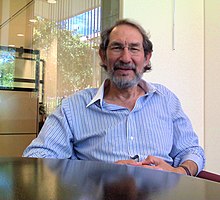Geoffrey West
Geoffrey Brian West (born December 15, 1940 in Taunton , Somerset ) is a British physicist.
Life
West graduated from Cambridge University with a bachelor's degree and received his PhD in theoretical nuclear physics from Stanford University in 1966 (dissertation: I. Form Factors of the Three-Body Nuclei II. Coulomb Scattering and the Form Factor of the Pion). He became a faculty member at Stanford before moving to Los Alamos National Laboratory , where he established the high energy physics group and became a Senior Fellow. He later turned to theoretical biology. From 2005 to 2009 he was President of the Santa Fe Institute , where he has been a Distinguished Professor since 2003.
plant
He is known for investigating the origins of scaling laws in biology, from cells to organisms and their metabolism to ecosystems (and extended by him to organizations, companies, economies and cities). He worked with two biologists from the University of New Mexico, James Brown and Brian Enquist.
Max Kleiber had found in the 1930s that the metabolic rate (the energy consumption per unit of time) in animals with body mass, which is proportional to volume, does not scale with a power of mass, as one might expect , but with the power . This is also an expression of the fact that the larger the animals, the more efficient the use of energy (energy consumption per unit of mass is proportional ). West and colleagues found out in 1997 that the exact power law is a result of the modeling of organisms as fractal (self-similar) networks in which metabolic products are distributed down to the cellular level. A characteristic of these networks in plants is that the cross-sectional area should remain the same on lower scales to ensure continuous flow. In animals with a circulatory system with pumping capacity via a heart, however, the cross-sectional area should increase in order to slow down the distributed fluid. One prediction was that blood pressure should be roughly the same in animals. The model was later extended to cells and cell components, where fractal network structures also exist. In the other direction, they also extended this to ecosystems, for example to tropical rainforests, in which a similar scaling of the size distribution was found both for individual trees and their branches and in the distribution of trees as components of the rainforest (again with potency ).
Other quantities of biological systems are distributed accordingly , such typical times as life spans or maturation times, and rates such as heartbeats per unit of time or evolution rates such as . In general, there is a scaling with powers in multiples of d space dimensions .
For cities, the size of which is measured according to the number of inhabitants, there were different scales, since in addition to the scales similar to biological systems, which are particularly found in infrastructure systems for supply (potencies around ), there are also dynamic processes from social interaction (innovation, increased prosperity) are near or above with potencies .
Honors
In 2013 he received the Leo Szilard Lectureship Award . He is a fellow of the American Physical Society .
Fonts
- with Necia Grant Cooper (Ed.): Particle Physics: A Los Alamos Primer. Cambridge UP 1988
- with James H. Brown (Ed.): Scaling in biology. Oxford University Press, 2000.
- Scale: The Universal Laws of Growth, Innovation, Sustainability, and the Pace of Life in Organisms, Cities, Economies, and Companies, Penguin Press, 2017.
Articles (selection):
- with James H. Brown, Brian J. Enquist: A general model for the origin of allometric scaling laws in biology, Science, Volume 276, 1997, pp. 122-126. PMID 9082983
- with James H. Brown, Brian J. Enquist: The fourth dimension of life: fractal geometry and allometric scaling of organisms, Science, Volume 284, 1999, pp. 1677-1679. PMID 10356399
- with James H. Brown, Brian J. Enquist: A general model for the structure and allometry of plant vascular systems, Nature, Vol 400, 1999, pp 664-667.
- with J. Brown, B. Enquist: A general model for ontogenetic growth, Nature, Volume 413, 2001, pp. 628-631, PMID 11675785
- with JH Brown, Woodruff: Allometric scaling of metabolic rate from molecules and mitochondria to cells and mammals, Proc. Nat. Acad., Vol. 99, 2002, Suppl 1, pp. 2473-2478, PMID 11875197
- with JF Gillooly u. a .: Effects of size and temperature on metabolic rate, Science, Volume 293, 2001, pp. 2248-2251. PMID 11567137
- with JH Brown a. a .: The fractal nature of nature: power laws, ecological complexity and biodiversity, Phil. Trans. Roy. Soc. B, vol. 357, 2002, pp. 619-626
- with JH Brown a. a .: Toward a metabolic theory of ecology, Ecology, Volume 85, 2004, pp. 1771-1789.
- with VM Savage u. a .: Scaling of number, size, and metabolic rate of cells with body size in mammals, Proc. Nat. Acad., Vol. 104, 2007, pp. 4718-4723
- with LM Bettencourt u. a .: Growth, innovation, scaling, and the pace of life in cities, Proceedings of the National Academy of Sciences, Volume 104, 2007, pp. 7301-7306.
Web links
Individual evidence
- ↑ According to the limitation due to heat radiation, which is proportional to the surface. For example, muscle strength scales in relation to body weight.
- ↑ George Johnson, Of Mice and Elephants: a Matter of Scale, New York Times, January 12, 1999
- ^ West, Enquist, Brown, A general quantitative theory of forest structure and dynamics, Proc. Nat. Acad. Sci., Vol. 106, 2008, pp. 7040-7045, online
| personal data | |
|---|---|
| SURNAME | West, Geoffrey |
| ALTERNATIVE NAMES | West, Geoffrey Brian |
| BRIEF DESCRIPTION | British physicist |
| DATE OF BIRTH | December 15, 1940 |
| PLACE OF BIRTH | Taunton |







